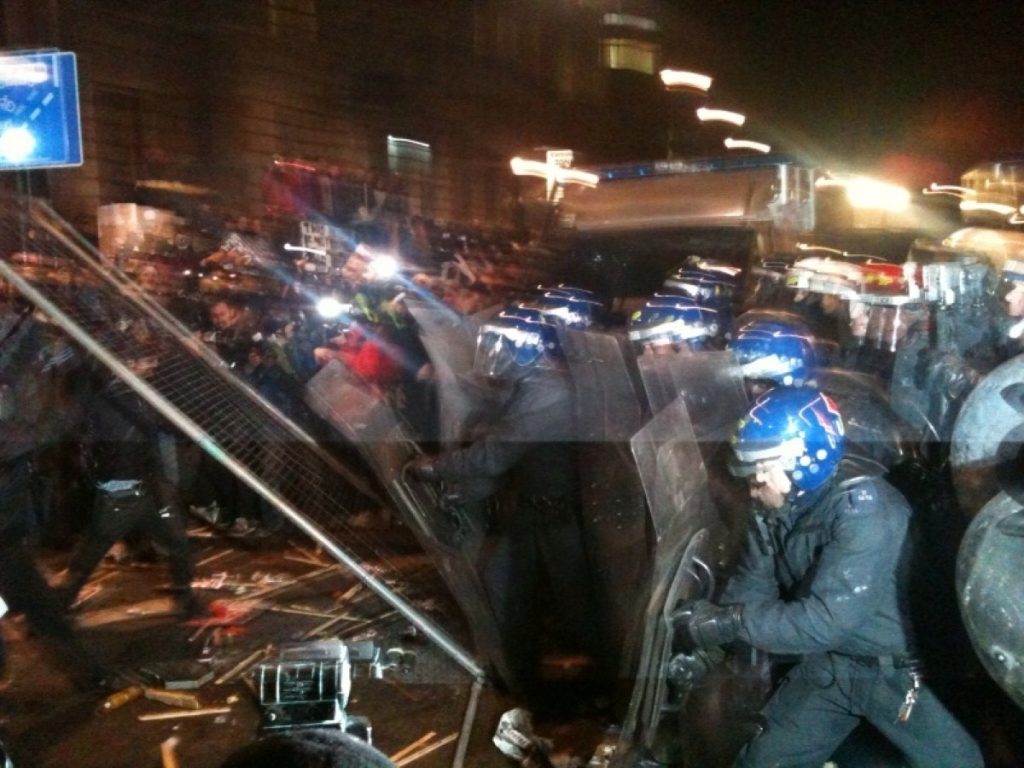Violence across London as government wins tuition fee vote
By Alex Stevenson, Peter Wozniak and Ian Dunt
The tuition fees vote has prompted fresh outbursts of violence among student protesters in Parliament Square and beyond.
After an afternoon and evening of clashes between riot police and protesters in Parliament Square, fighting started to break out throughout the centre of the capital.
In Trafalgar Square demonstrators managed to set fire to the main Christmas tree, but the fire was quickly extinguished, the Metropolitan police said.


Prince Charles’ car came under attack as he and Camilla travelled to a variety performance.
“It is clear that a minority of protestors came determined to provoke violence, attack the police and cause as much damage to property as possible,” the prime minister said in a statement.
“They must face the full force of the law. The police have confronted considerable danger, and a number have been injured as they sought to uphold the right to peaceful protest.
“It is shocking and regrettable that the car carrying the Prince of Wales and the Duchess of Cornwall was caught up and attacked.”
A handful of masked troublemakers smashed windows at the supreme court building and police were deployed on Oxford Street after reports of broken windows emerged.
The Metropolitan police condemned the “wanton violence”, adding: “This is why we use containment as a tactic.”
Close to parliament, riot police were forced to defend the Treasury after it briefly looked as if demonstrators could infiltrate the key government department.
Officers briefly resorted to blocking an opened window with shields in a bid to prevent demonstrators entering the building.
It followed protesters using rocks to smash open the window at the Treasury, in an angry reaction to the news from parliament that the coalition had won its tuition fees vote by a majority of 21.
But a line of riot police in front of the Treasury managed to push the protesters back, ending the likelihood of a full-scale breach.
Demonstrators chanted ‘shame on you’ and booed as the result of the vote filtered through in Parliament Square.
Police began the controversial kettling tactic at around 15:40 GMT. Officers promised to let peaceful protestors out and be careful of vulnerable people and children, insisting those groups could leave the Square from the Whitehall end. Eyewitnesses said that it was almost impossible for people to leave the area once the violence broke out, however.
Twenty-two people have been arrested so far, the Met said – including three arrests for assault on police, one on drunk and disorderly charges, nine for violent disorder, two for arson and four for burglary.
Twenty-two protesters and nine officers are believed to have been injured. Six of the injured police required hospital treatment.
“Officers came to work today to facilitate peaceful protest but have come under continued and violent attacks from protestors,” the Met said in a statement.
“Officers have had to face a significant level of violence including fences, missiles and flares being thrown at them.”
The statement added: “The Metropolitan Police Service is extremely disappointed with the actions of many protestors who from a very early stage deviated from the agreed route.”
It followed earlier attempts to break through police lines in Parliament Square, after riot police deployed to defend the Commons.
The area nearest Westminster Abbey saw riot police come under sustained pressure in mid-afternoon from demonstrators, who forced the entire line back about ten yards. Officers responded by sending in reinforcements, tripling police ranks in a bid to stabilise the situation.
One officer sustained a serious neck injury after being knocked unconscious, the Met said, in one of the first injuries.
He was rushed to hospital, as was a mounted branch officer who sustained leg injuries.
Commenting on reports that police horses had charged protestors, the Met added: “The mounted branch have been used legitimately to provide essential re-enforcement to police officers who were coming under attack.”
After dark fell fireworks began to be set off at regular intervals and music by the Beatles and Bob Dylan was played on loudspeakers.
Earlier demonstrators tore down sections of the wire fences which had closed Parliament Square off to pedestrians, passing sections of the fence over their heads towards the police – who were forced to quickly clear them.
Missiles were thrown into the secure area of parliament shortly before student protestors made their breakthrough.
They had been contained in an area close to the Treasury, but broke through and quickly massed from Whitehall to Westminster Abbey.
The violence came as the culmination of weeks of student protests, as activists from across the country gathered in the capital on the day of the tuition fees vote.
The demonstration appears to be the biggest since the nascent student movement began.
As the December sun shone on the activists, who included lecturers and members of the public as well as students, motorists beeped their horns in support. There were some earlier isolated scenes of panic as groups of demonstrators ran down side streets following rumours of ‘kettling’, but the early stages of the protest were peaceful and good natured.
A small number of students attempted to disrupt the debate inside the Commons from the strangers’ gallery, but were quickly bundled out by doorkeepers. Other students watching the debate applauded loudly but, because of the glass screen separating the gallery from the Commons chamber, few MPs noticed.
Protesters have previously complained of recent police tactics, which saw teenage girls ‘kettled’ in London in the freezing cold well into the evening, police violence and the use of horse charges.
Even before the march began, activists were planning another day of action for next Monday – this time to save the Educational Maintenance Allowance (EMA).









